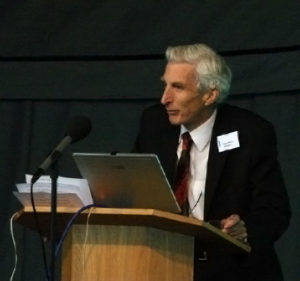[AUTHOR’S NOTE: This is the final article originally published at Examiner.com in the series on the theory of evolution, on a favorite topic of mine: is it possible to quantify the luck that would be necessary to explain our existence, without invoking a supernatural Creator of all things? The secular approach to eliminating God from creation can take at least two different, diametrically opposed forms. The goal of both is to eliminate a problem called fine-tuning of this universe, described in this article.
First, there is the multiverse hypothesis, which improves the probability of “this” (successful) universe by speculating an unknown number of unsuccessful universes were also created at the Big Bang anomaly. The other option is that it may be argued that the creation of the universe was actually deterministic (Grand Unified Theory, or GUT) assuming that this universe had no choice except to exist, and to enable complex life to exist.]
Pontedera Compounded improbabilities
 Cosmologist Sir Martin Rees has declared that “just six numbers” dictate the nature of our universe. For clarity and ease of discussion, these six values shall be referred to as “cosmic factors” for the remainder of this article.
Cosmologist Sir Martin Rees has declared that “just six numbers” dictate the nature of our universe. For clarity and ease of discussion, these six values shall be referred to as “cosmic factors” for the remainder of this article.
Apparently to avoid giving a divine Creator any credit, Rees said,
These six numbers constitute a ‘recipe’ for a universe. Moreover, the outcome is sensitive to their values: if any one of them were to be ‘untuned’, there would be no stars and no life. Is this tuning just a brute fact, a coincidence? Or is it the providence of a benign Creator? I take the view that it is neither. An infinity of other universes may well exist where the numbers are different.
It’s the old “multiple universe” trick, as Maxwell Smart would say. But, as with any theory, there are problems. According to Rees, the six cosmic factors are:
- omega (value=1) to represent the amount of matter in the universe.
- Epsilon (value=0.007) represents the degree to which atomic nuclei are bound together.
- “D” is the number of dimensions (value=3).
- “N” is the strength of electrical forces that bind atoms, divided by the force of gravity:(value= where can i buy Seroquel online without a prescription 1,000,000,000,000,000,000,000,000,000,000,000,000).
- “Q” is a number that represents two fine-tuned fundamental energies (value=1/100,000).
- Lambda (value=0.7) represents a measurement of anti-gravity in the universe.
Also according to Rees, the slightest change in value in any of the cosmic factors would result in a universe that would not support life. One less zero for the value of “N”, for example, would mean this universe failed. His proposed alternative to supernatural creation for resolving the statistical improbability of our “Goldilocks” universe is an infinite number of “universes”, also known as the “multiverse.”
A simple formula (using the right values, of course) should produce the cumulative improbability of the combined cosmic factors, expressed as a single value:
Probability(Universe) = Probability(Omega) * Probability(Epsilon) * Probability(N) * Probability(D) * Probability(Q) * Probability(Lambda)
Even if the probability value of variation in each universal factor were as low as one percent, the total improbability of the Big Bang producing our perfect universe are considerably lower because of the compounded risk of variation in any one of the six — not unlike the odds against winning a lottery [the following example is for illustrative purposes only, not actual values]:
.01 * .01 * .01 * .01 * .01 * .01 = 0.000000000001 chance of total success
Thus for life to exist, we must “win” more than one lottery.
The likelihood of variation in any cosmic factor is probably much greater than one in a hundred. Therefore, we may reasonably conclude that odds against the origin of our universe were ridiculously low. But even if my simplistic example were accurate, an undirected origin of life would be even more improbable because the improbable universe was first required.
The odds against the origin of life increase exponentially — the improbabilities do not merely aggregate; they are compounded because the existence of life as we know it is actually predicated on the existence of the universe that supports it. According to (co-discoverer of DNA) Francis Crick, the random assembly of six billion pieces of information found in the double helix should have taken several billion years to form, leaving practically no time for evolution theory to work its magic.
Francis Crick wrote,
An honest man, armed with all the knowledge available to us now, could only state that in some sense, the origin of life appears at the moment to be almost a miracle, so many are the conditions which would have had to have been satisfied to get it going. (Life Itself, pg 88)
Naturally, I aspire to be an honest man. Crick proposed a hypothesis called directed panspermia to solve the time problem without invoking a divine Creator, effectively moving the problem from earth into outer space.
Nobel Laureate in Chemistry Ilya Prigogine claimed,
The statistical probability that organic structures and the most precisely harmonized reactions that typify living organisms would be generated by accident is zero.
Even if Prigogine was wrong and the statistical probability of undirected life was an incredibly small number but slightly greater than zero, it would be further reduced when compounded by the improbability of our anthropic universe. To properly evaluate “the Big Scheme” of things, life cannot be separated from the environment that supports it.
We must also ask: even if our universe could have “accidentally” happened through a fluke related to quantum mechanics, why did entropy fail to break down the chemical compounds before they had time to complete assembly of the first form of life?
Speciation theory allegedly describes the undirected mutations that occur through the mechanism of sexual reproduction.
After countless generations, two compatible, paired organisms diversify solely through the mechanisms of sexual reproduction and turn into organisms as unlike as oak trees, sperm whales and humans — all from the same single, original cell called LUCA.
This concept is difficult to quantify into any numerical probability.
For sake of argument, let’s say it’s a fifty/fifty probability — essentially a coin flip, whether a vampire bat could have evolved into existence without intelligent direction. Please consider the complex ability by which they are able to fly by night to hunt: echo location navigation. And take into consideration the fact that a flying mammal and an aquatic mammal possess this same capability and ask yourself why we should assume these two wildly disparate creatures in most respects should share a common ancestor. Simply throw away the concept of irreducible complexity, at least for a moment, in order to consider the whole problem.
Even in that scenario, that flip of the coin (which gave us dolphins, whales, and vampire bats) had to happen after two unimaginably unlikely events happened in the right order. The improbabilities of the anthropic universe and abiogenesis being created by nothing adversely affect the odds of speciation happening by random chance, further compounding its improbability factor.
No matter how hard you try, the numbers just don’t logically add up.

Speak Your Mind